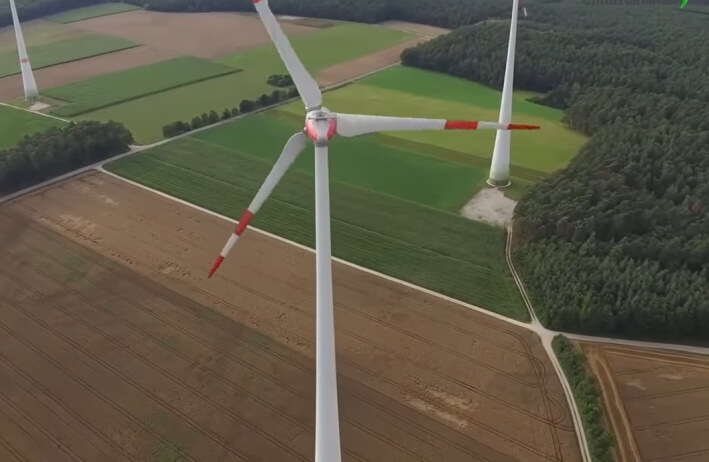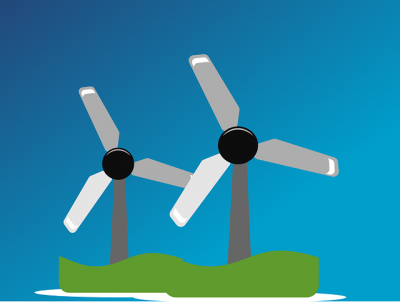Wind turbines are a popular energy production system in the USA. Wind turbines are generally used for mass energy production. As the Installation cost of the wind turbine is so expensive, it is only used by the government and some largest companies like TESLA. It is not yet available for the general consumer. So, if people like us want to benefit from the green energy, then we have to depend on the solar system.

As the solar system is available for general people so they know a lot about how it works. But the energy production system of the wind turbine is unknown to many of us. The general principle of the production process is almost the same for every energy production system. Let’s know the details of how the wind turbine works to produce energy.
Energy Source of Wind Turbine

It is easy to understand from the name wind. Wind turbine only produces the energy from the wind. If there is no air (impossible) then the wind turbine will not work to produce the energy. So, the energy production rate of a wind turbine merely depends on the air flow rate.
How Does Wind Turbine Works

Normally almost every type of wind turbine has three propellers. When the air flows through the turbine the propeller starts turning. A rotor is attached to the shaft of the turbine that spins the generator to produce Direct electricity.
Generally, wind turbines are used in a big field or rural area. The general purpose of this is not that wind turbines are big but to get better airflow. When the sun heats on an empty large surface the air temperature becomes hot. And hot air temperature is lighter than cool air temperature. So, when the lighter air flows it flows at more speed than heavy air. This principle is for a normal air flowing system.
So, after heating by the air the generator uses the shaft to spin a rotor of the generator that charges the magnet inside the turbine. This magnetic charge actually produces the energy. Then a transmitter receives the magnetic charge and converts it into electricity and sends it to the power station. The power station then distributes the energy to the consumers.
For visual understanding watch the video here:
Why Wind Turbine Uses a Transmitter
The transmitter of the wind turbine used to send the electricity to the power station at high voltage for fast energy distribution. The answer is understandable from the solar energy distribution process. When the solar panel produces the electricity, it is sent to the battery storage. The voltage of the battery is compatible with the voltage of the appliances. If we don’t use the battery the solar panel will distribute the electricity at a high voltage rate.
So, if the wind turbine does not send the electricity to a power station through the transmitter, the high voltage of the wind turbine energy will cause electric Spikes, Electrical Noise, Blackouts.
How Does the Wind Turbine Generate Electricity?
Wind turbines work by converting the kinetic energy in the wind into mechanical power. This mechanical power is then used to drive an electrical generator to produce electricity. The blades of the turbine are shaped and positioned in such a way that the force of the wind is directed onto them. As the blades turn, they spin a shaft connected to the generator. This rotation drives the generator to create electricity, which is then fed into the electrical grid.
What Components of the Wind Turbine Are Necessary to Generate Electricity?
The main components of a wind turbine that are necessary to generate electricity are the rotor, nacelle, generator, gearbox, tower, yaw mechanism, and anemometer. The rotor consists of the blades, hub, and nose cone, and is responsible for capturing the wind’s kinetic energy and transforming it into rotational energy. The nacelle houses the gearbox, generator, and other electrical components.
The gearbox is used to increase the rotational speed of the rotor to match the optimal speed for the generator. The generator then converts the mechanical energy of the rotor into electrical energy. The tower is used to raise the turbine to an optimal height for capturing the wind’s energy.
The yaw mechanism is responsible for orienting the rotor in the direction of the oncoming wind. The anemometer is used to measure the wind’s speed and direction in order to optimize the turbine’s performance.
Types of Wind Turbine

There are two types but different sizes of wind turbine available for energy production. These are the Vertical axis wind turbine which is a lift type and the horizontal axis wind turbine. The vertical axis wind turbine looks like the shape of an egg.
And the horizontal axis wind turbine is what we generally see the wind turbine around us. The horizontal axis wind turbine is taller and bigger than the vertical axis wind turbine.
Both of these two-wind turbines have pros and cons. The horizontal axis wind turbine is more durable than the vertical axis. It can pitch the rotor blades in the storm to prevent damages. The horizontal axis is taller than the vertical axis.
That’s why it gets more airflow compared to the vertical axis. Horizontal axis wind turbines are the self-started wind turbines. On the other hand, the vertical axis sometimes needs extra electricity to start the blade rotation.
Vertical axis wind turbine require less maintenance and are easy to transport. While the horizontal axis is opposite to it. The installation process is also difficult for the horizontal axis wind turbine.
Another type of wind turbine that is not used for mass energy production is Ducted Wind Turbines. This kind of wind turbine is generally used on the rooftop. You can use this wind turbine for your business center or house. This is like a door, through which the wind enters and heats the propeller. The propeller then generates the electricity like above two wind turbines.
So, if you want to use wind turbines for your house you can install the Ducted wind turbines. It’s obviously good to have an alternative energy source. If you do not want to use the solar energy system then you can use this.

Benefits and Drawbacks of Wind Turbine Energy
Though the wind turbines work is a bit complicated, it is the most popular method nowadays. So, wind turbine energy has some advantages as well as disadvantages. This table is enough to know quickly in this matter.
| Benefits | Drawbacks |
| Clean source of power | Environmental impact |
| Renewable Source | Wind Reliability |
| Low operating costs | Intermittent |
| Cost-effective energy to numerous homes | Lead to noise and visual pollution |
| Space efficient | Threat to Wildlife |
| Extra savings for land owners | Expensive to set up |
| Modern technology used | Safety of people at risk |
| Keeps water clean | Limited locations |
Read More:
About This Writer

Hi, I am responsible for the 'Homeowners Power Solutions' category. My name is Liam Jaxon and a licensed technician with 7 years of experience in vehicle batteries, electrical gadgets, and home appliances. My working experience in different residential & light commercial electrical sectors and the automobile industry helped to acquire vast knowledge in this industry.